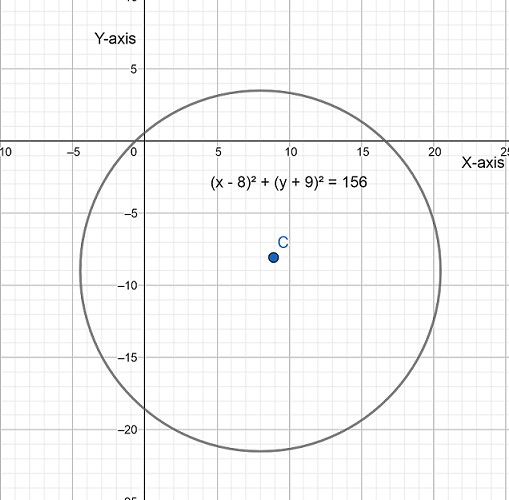
How do you determine circle, parabola, ellipse or hyperbola from the equation ${{x}^{2}}+{{y}^{2}}-16x+18y-11=0$?
Answer
522.6k+ views
Hint: We will first try to group the terms present in the equation and then complete the square for both x and y terms. Then we will compare the obtained equation with the general equations of circle, parabola, ellipse and hyperbola to get the desired answer.
Complete step-by-step solution:
We have been given an equation ${{x}^{2}}+{{y}^{2}}-16x+18y-11=0$.
We have to determine whether the given equation is of circle, parabola, ellipse or hyperbola.
Now, let us group the x and y terms then we will get
$\Rightarrow {{x}^{2}}-16x+{{y}^{2}}+18y=11$
Now, to complete the square for x we need to add 64 both sides of the equation. Then we will get
$\begin{align}
& \Rightarrow {{x}^{2}}-16x+64+{{y}^{2}}+18y=11+64 \\
& \Rightarrow {{x}^{2}}-8\times 2x+{{8}^{2}}+{{y}^{2}}+18y=11+64 \\
& \Rightarrow {{\left( x-8 \right)}^{2}}+{{y}^{2}}+18y=75 \\
\end{align}$
Now, to complete the square for y we need to add 81 both sides of the equation. Then we will get
$\begin{align}
& \Rightarrow {{\left( x-8 \right)}^{2}}+{{y}^{2}}+18y+81=75+81 \\
& \Rightarrow {{\left( x-8 \right)}^{2}}+{{y}^{2}}+2\times 9y+{{9}^{2}}=156 \\
& \Rightarrow {{\left( x-8 \right)}^{2}}+{{\left( y+9 \right)}^{2}}=156 \\
\end{align}$
Now, we know that the above obtained equation is similar to the standard equation of circle which is given as ${{\left( x-h \right)}^{2}}+{{\left( y-k \right)}^{2}}={{r}^{2}}$

Hence the given equation represents the circle.
Note: Alternatively by analyzing some points we can determine whether the equation belongs to a circle, parabola, ellipse or hyperbola.
If the coefficients of both ${{x}^{2}}$ and ${{y}^{2}}$ are the same then it is a circle. If the coefficients of both ${{x}^{2}}$ and ${{y}^{2}}$ are different and have positive or negative value then it is an ellipse. If there is only one squared term then it is a parabola and if there is one squared term and has negative coefficient then it is a hyperbola.
From the above points the given equation has the same coefficients of both ${{x}^{2}}$ and ${{y}^{2}}$ so it is an equation of circle.
Complete step-by-step solution:
We have been given an equation ${{x}^{2}}+{{y}^{2}}-16x+18y-11=0$.
We have to determine whether the given equation is of circle, parabola, ellipse or hyperbola.
Now, let us group the x and y terms then we will get
$\Rightarrow {{x}^{2}}-16x+{{y}^{2}}+18y=11$
Now, to complete the square for x we need to add 64 both sides of the equation. Then we will get
$\begin{align}
& \Rightarrow {{x}^{2}}-16x+64+{{y}^{2}}+18y=11+64 \\
& \Rightarrow {{x}^{2}}-8\times 2x+{{8}^{2}}+{{y}^{2}}+18y=11+64 \\
& \Rightarrow {{\left( x-8 \right)}^{2}}+{{y}^{2}}+18y=75 \\
\end{align}$
Now, to complete the square for y we need to add 81 both sides of the equation. Then we will get
$\begin{align}
& \Rightarrow {{\left( x-8 \right)}^{2}}+{{y}^{2}}+18y+81=75+81 \\
& \Rightarrow {{\left( x-8 \right)}^{2}}+{{y}^{2}}+2\times 9y+{{9}^{2}}=156 \\
& \Rightarrow {{\left( x-8 \right)}^{2}}+{{\left( y+9 \right)}^{2}}=156 \\
\end{align}$
Now, we know that the above obtained equation is similar to the standard equation of circle which is given as ${{\left( x-h \right)}^{2}}+{{\left( y-k \right)}^{2}}={{r}^{2}}$

Hence the given equation represents the circle.
Note: Alternatively by analyzing some points we can determine whether the equation belongs to a circle, parabola, ellipse or hyperbola.
If the coefficients of both ${{x}^{2}}$ and ${{y}^{2}}$ are the same then it is a circle. If the coefficients of both ${{x}^{2}}$ and ${{y}^{2}}$ are different and have positive or negative value then it is an ellipse. If there is only one squared term then it is a parabola and if there is one squared term and has negative coefficient then it is a hyperbola.
From the above points the given equation has the same coefficients of both ${{x}^{2}}$ and ${{y}^{2}}$ so it is an equation of circle.
Recently Updated Pages
Master Class 11 Economics: Engaging Questions & Answers for Success

Master Class 11 English: Engaging Questions & Answers for Success

Master Class 11 Social Science: Engaging Questions & Answers for Success

Master Class 11 Biology: Engaging Questions & Answers for Success

Class 11 Question and Answer - Your Ultimate Solutions Guide

Master Class 11 Business Studies: Engaging Questions & Answers for Success

Trending doubts
What is meant by exothermic and endothermic reactions class 11 chemistry CBSE

10 examples of friction in our daily life

One Metric ton is equal to kg A 10000 B 1000 C 100 class 11 physics CBSE

Difference Between Prokaryotic Cells and Eukaryotic Cells

What are Quantum numbers Explain the quantum number class 11 chemistry CBSE

1 Quintal is equal to a 110 kg b 10 kg c 100kg d 1000 class 11 physics CBSE




